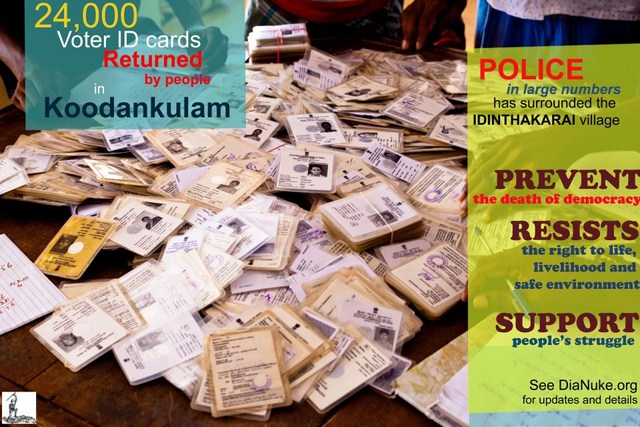This post was first published in Global Voices Online.
Concerns have been sparked that the Kudankulam Nuclear Power Project (KKNPP) currently under construction in the Tirunelveli district of Tamil Nadu, India, may have similar vulnerabilities to the ill-fated Fukushima nuclear power plant of Japan. Activists fear that in the case of an earthquake followed by a tsunami in the Indian Ocean, there could be an accident similar to the radiation leak at the Japanese coastal nuclear plant last year.
Construction started more than a decade ago and KKNPP is expected to be in operation soon. S. P. Udayakumar of the voluntary organisation ‘People's Movement Against Nuclear Energy' (PMANE) lists 13 reasons why the activists and locals do not want the power plant to start. He stress that:
Protest and arrests:
Shedding a light onto the government crackdown on the protesters, Kracktivist cites:
The protests continued as the ‘People’s Movement Against Nuclear Energy' (PMANE) recently launched three campaigns against the Kudankulam Nuclear power Plant, reports Kracktivist:
According to a press release, “The People’s Movement Against Nuclear Energy (PMANE) called off the planned event at Idinthakarai on May 10, 2012 as the District authorities have clamped down prohibitory orders such as 144 in and around Kudankulam area”.
However, some 9,000 people still participated in a sit in, with several hundred on an indefinite fast. The hunger strike has been going on since last month. DiaNuke/Aam Janata has posted some pictures from Kudankulam which depicts women on hunger strike and villagers living under constant fear.
The Chief Minister of Tamil Nadu, Ms. Jayalalithaa, has vowed that the plant will start to function soon. Anuj Wankhede at DiaNuke invited a debate with Dr. M R Srinivasan, the former chief of India’s Atomic Energy Commission on whether the Kudankulam reactors are really the “safest in the world”, as claimed by the authorities.
The anti-Kudankulam activists are willing to end their protest if the government meets their demands.
Concerns have been sparked that the Kudankulam Nuclear Power Project (KKNPP) currently under construction in the Tirunelveli district of Tamil Nadu, India, may have similar vulnerabilities to the ill-fated Fukushima nuclear power plant of Japan. Activists fear that in the case of an earthquake followed by a tsunami in the Indian Ocean, there could be an accident similar to the radiation leak at the Japanese coastal nuclear plant last year.
Construction started more than a decade ago and KKNPP is expected to be in operation soon. S. P. Udayakumar of the voluntary organisation ‘People's Movement Against Nuclear Energy' (PMANE) lists 13 reasons why the activists and locals do not want the power plant to start. He stress that:
More than 1 million people live within the 30 km radius of the KKNPP which far exceeds the AERB (Atomic Energy Regulatory Board) stipulations. It is quite impossible to evacuate this many people quickly and efficiently in case of a nuclear disaster at Koodankulam.
 |
| Protest campaign against Koodankulam Nuclear Power Plant. Image courtesy Kracktivist, used with permission. |
Shedding a light onto the government crackdown on the protesters, Kracktivist cites:
Between 10.9.2011 and 23.12.2011, police had filed 107 FIRs (field investigation reports) against 55795 people and “others,” among whom 6800 have been charged with “sedition” and/ or “waging war against the State.”In March 2012, police arrested approximately 200 anti-nuclear protesters objecting the resumption of work on one of the two 1 GW (gigawatt=1000 megawatt) reactors, a day after the local government restarted work on the project. A Public Interest Litigation (PIL) has also been filed against KKNPP at India's Supreme Court. Amnesty International has written a letter to the Prime Minister expressing their dismay on the detainment of the protesters. However, there were also rallies and protests in favor of commissioning the nuclear power plant.
The protests continued as the ‘People’s Movement Against Nuclear Energy' (PMANE) recently launched three campaigns against the Kudankulam Nuclear power Plant, reports Kracktivist:
Collection of signatures by villagers who oppose the nuclear plant and surrender of voter identity cards will be observed in 60 villages belonging to three neighboring districts while [a] ‘respect India’ campaign will be observed throughout the country.On May 9, around 23,000 people belonging to nine villages in Tamil Nadu surrendered their voter identity cards to draw attention to the continuing ignorance of the peaceful protest against the KNPP. The government did not take it lightly; Kracktivist also reported that thousands of police personnel were deployed near Idinthakarai village and a crackdown seemed likely.
According to a press release, “The People’s Movement Against Nuclear Energy (PMANE) called off the planned event at Idinthakarai on May 10, 2012 as the District authorities have clamped down prohibitory orders such as 144 in and around Kudankulam area”.
 |
| Protesters on hunger strike. Image courtesy DiaNuke/Aaam Janata, used with permission. |
The Chief Minister of Tamil Nadu, Ms. Jayalalithaa, has vowed that the plant will start to function soon. Anuj Wankhede at DiaNuke invited a debate with Dr. M R Srinivasan, the former chief of India’s Atomic Energy Commission on whether the Kudankulam reactors are really the “safest in the world”, as claimed by the authorities.
The anti-Kudankulam activists are willing to end their protest if the government meets their demands.
























0 comments:
Post a Comment